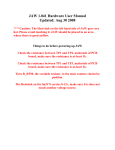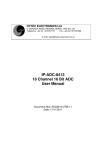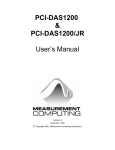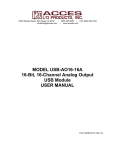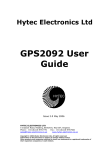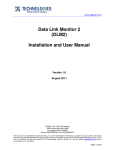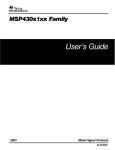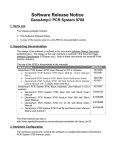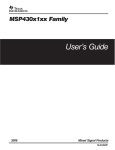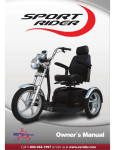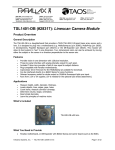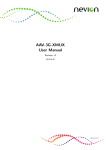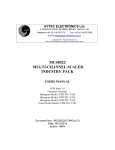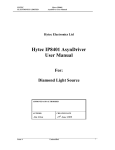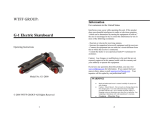Download User Manual - Hytec Electronics Ltd
Transcript
HYTEC ELECTRONICS Ltd HEAD OFFICE: 5 Cradock Road, Reading, Berkshire, RG2 0JT, UK Telephone: +44 118 9757770 Fax: +44 118 9757566 E-mail: [email protected] Web:www.hytec-electronics.co.uk DAC8404 16-CHANNEL 16-BIT DAC INDUSTRY PACK User Manual Document Nos.: DAC8404/ UTM/1.0 Date: 1/10/2008 Author: AB/MCB/DAN Hytec Electronics Ltd DAC8404/UTM/x/1.0 Date 11/07/07 CONTENTS 1. FEATURES..........................................................................................................................................3 2. PRODUCT SPECIFICATIONS ........................................................................................................3 3. OPERATING MODES .......................................................................................................................4 3.1 3.2 USING REGISTERS TO UP DATE DACS ..................................................................................4 USING MEMORY TO UP DATE DACS .....................................................................................4 4. MEMORY MAP..................................................................................................................................5 5. APPLICATION REGISTERS ...........................................................................................................5 5.1 5.2 5.3 5.4 5.5 5.6 5.7 5.8 5.9 CONTROL & STATUS REGISTER (CSR)..........................................................................................6 MEMORY POINTER.........................................................................................................................7 NUMBER OF UPDATES 1.................................................................................................................7 CLOCK RATE..................................................................................................................................7 INTERRUPT VECTOR ......................................................................................................................7 FULL-SCALE TRIM & ID PAGE NO.................................................................................................8 NUMBER OF UPDATES 2.................................................................................................................8 DAC DATA REGISTERS .................................................................................................................9 DAC COMMAND REGISTERS .......................................................................................................10 6. ID PROM ...........................................................................................................................................11 7. CALIBRATION ................................................................................................................................12 7.1 7.2 7.3 7.4 7.5 7.6 7.7 7.8 BIPOLAR CALIBRATION FORMULA ..............................................................................................12 UNI-POLAR CALIBRATION FORMULA ..........................................................................................13 ID PAGE 1 (PG2 = 0, PG1 = 0, PG0 = 1) +/- 10V SCAN CALIBRATION VALUES LAYOUT...........14 ID PAGE 2 (PG2 = 0, PG1 = 1, PG0 = 0) +/- 10V SCAN CALIBRATION VALUES LAYOUT...........15 ID PAGE 3 (PG2 = 0, PG1 = 1, PG0 = 1) +/- 10V SCAN CALIBRATION VALUES LAYOUT...........16 ID PAGE 4 (PG2 = 1, PG1 = 0, PG0 = 1) +10V SCAN CALIBRATION VALUES LAYOUT. .............17 ID PAGE 5 (PG2 =1, PG1 = 1, PG0 = 0) +10V SCAN CALIBRATION VALUES LAYOUT...............17 ID PAGE 6 (PG2 = 1. PG1 = 1, PG0 = 1) +10V SCAN CALIBRATION VALUES LAYOUT. .............18 8. SELECTION OF THE +/-12 VOLT POWER SUPPLY ...............................................................20 9. I/O CONNECTOR – 50 WAY ON 8404 DAC BOARD.................................................................21 10. HYTEC TRANSITION CARD 8204 CONNECTIONS ............................................................22 11. APPENDIX A: PSEUDO CODE EXAMPLES ..........................................................................23 11.1 11.2 DAC UPDATE BY REGISTER.........................................................................................................23 UPDATE DAC FROM WAVEFORM MEMORY DATA .....................................................................23 Page 2 of 23 Hytec Electronics Ltd DAC8404/UTM/x/1.0 Date 11/07/07 1. Features The Hytec IP-DAC-8404 is a single-width Industry Pack that provides 16 channels of simultaneously updated digital to analogue conversion with the following characteristics:• • • • • • • • • • • • • • • • • • • • 16 independently programmed channels 5 programmable ranges per channel 0-5V, 0-10V +/-5V, +/-10V and +/-2.5V 16 bits resolution 64K samples per channel memory. Registered or memory fetch updates. Two independent digitally controlled full-scale trims for each group of eight channels. Low offset error - +/-5mV typical (With software Cal applied +/-0.5mV) Low gain error - +/-5LSBs typical (With software Cal applied +/-2.5LSBs typ.+/-4.5LSBs max) Low error drift - 2ppm per deg C +/- 10mA current drive capability with continuous short-circuit protection Straight binary code 10KHz update rate Power-On Reset to 0V 100V system to plant isolation when externally powered Board serial number, PCB issue and firmware version held on ROM. External Triggering Continuous function generation. Internal/External update clock rates Internal update clock rates programmable (10KHz,5KHz,2KHz,1KHz,500Hz,200Hz,100Hz,50Hz,20Hz,10Hz,5Hz,2Hz and 1Hz) Pin-out compatible with DAC8402 (in command default mode). 2. Product Specifications Size: Single width Industry Pack 1.8ins x 3.9 ins Operating temp: 0 to 45 deg C ambient Number of channels: 16 DAC resolution: 16 bits Data format: 16 bits binary Range: Programmable 0V to 5V, 0V to 10V, +/-5V, +/-10V, and +/-2.5V FSR (Full Scale Reading) Output current: +/-10mA @ FS Capacitive load: Stable up to 20,000pF Short circuit duration: Continuous OverV withstand: No internal protection from external voltages provided Update rate: 10KHz max Power: +5V @ 300mA typical +/-12V @ 120mA typical when switched to internal (external load dependent) Isolation: 100V via opto-isolators (if externally powered) Integral non-linearity: +/-1LSB max Diff non-linearity: +/-1LSB max Offset error: +/-200uV max Gain drift: 3ppm per deg C Gain error: +/-5LSBs typ. +/-16LSBs max. Output slew rate: +/-13V/us min. Settling time: 20us max.to 0.005% of final value for 1000pF load capacitance Page 3 of 23 Hytec Electronics Ltd DAC8404/UTM/x/1.0 Date 11/07/07 3. Operating Modes There are two operating modes:1. Registered – the DAC outputs are controlled by the contents of the DAC registers. 2. Memory – the outputs are updated for the programmed number of samples at the programmed clock rate. All the outputs are updated serially but change together (there will be slight changes due to differences in the slew rate of the amplifiers (about +/-1uS) at the end of an internal update cycle. The outputs may be updated at a rate of up to 10KHz. The two methods to update the 8404 DACs are detailed below. 3.1 USING REGISTERS TO UP DATE DACs There are 16 individual DACs on the IP Card with 16 Data & Command DAC registers to access each one. This allows the user to set if required each DAC to different voltage ranges. The DACs are serially loaded with a 32 bit data stream comprising of the first 16 bits with the command word, to set the required voltage range, and the last 16 bits correspond to the data to set the output of the DAC to. Therefore, both the data and command registers must both be set the DACs to operate correctly. The DACs are arranged in two groups, DACs 1 to 8 are daisy chained together to form bank A and DACs 9 to 16 daisy chained to form bank B. Once the registers have been loaded, the module can then be ARMed and the data from the registers will be serially loaded from one DAC to the next until all the data has been passed to all of the DACs. At this point the DAC outputs are automatically updated giving 16 simultaneous outputs. While the unit is ARMed the DACs are constantly refreshed with the contents of the registers which can be changed during this time. There is a delay which is fixed of approximately 32us after ARM is set, before all the outputs change together. 3.2 USING MEMORY TO UP DATE DACs In this mode the data to be sent to the DACs is loaded from memory instead of the DAC Data register, however the command for each DAC is still required, but only has to be set once at the start. Once the DAC Command has been set this remains unchanged, unless the voltage range is changed, then the new command must be written again. The onboard memory is first loaded with the required data and the number of memory locations used is entered in to the Number of Updates (NCO) register. With the DAC Command Register already written and set, the Control and Status Register (CSR) is then set to enable memory updates and ARM to unit with a software command. A trigger can then be issued either by a software command or by an external trigger to start down loading the data held in memory to the DACs via the registers as detail above. In this mode the registers are updated with new data from the memory at the update clock rate which is derived either internally or externally. The memory address is automatically incremented. When the programmed number of output has occurred the unit will stop and generate an interrupt if enabled or if set in continues mode the address counter will be zeroed and the output repeated (no interrupt generated in continues mode) until the ARM bit is cleared or the continues bit CC in the CSR is cleared. Page 4 of 23 Hytec Electronics Ltd DAC8404/UTM/x/1.0 Date 11/07/07 4. Memory Map There are two main buffer memories of 512k updates each (lower and upper buffers) These are each divided into sixteen segments allocated to updates for DAC1 to DAC16. When DAC16 has been updated from the top of the lower buffer, the Half Full Flag status is set and when it has been updated from the top of the upper memory buffer the Full Flag status is set. Lower Conversion Memory DAC16 conversions DAC15 conversions DAC14 conversions DAC13 conversions DAC12 conversions DAC11 conversions DAC10 conversions DAC9 conversions DAC8 conversions DAC7 conversions DAC6 conversions DAC5 conversions DAC4 conversions DAC3 conversions DAC2 conversions DAC1 conversion 32k DAC1 conversion 32k-1 DAC1 conversion 2 DAC1 conversion 1 Upper Conversion Memory DAC16 conversions DAC15 conversions DAC14 conversions DAC13 conversions DAC12 conversions DAC11 conversions DAC10 conversions DAC9 conversions DAC8 conversions DAC7 conversions DAC6 conversions DAC5 conversions DAC4 conversions DAC3 conversions DAC2 conversions DAC1 conversion 64k DAC1 conversion 64k-1 DAC1 conversion 32k+2 DAC1 conversion 32k+1 . 5. Application Registers There are eight application specific (I/O) registers; the CSR, the number of samples per trigger, the Conversion Pointer, Clock Rate, Interrupt Vector, Full Scale Trim & ID Page No, DAC Data Registers and DAC Command Registers. Page 5 of 23 Hytec Electronics Ltd DAC8404/UTM/x/1.0 Date 11/07/07 5.1 Control & Status Register (CSR) Read/Write Address: 0 hex D15 D14 D13 D12 D11 D10 D09 D08 D07 D06 D05 D04 D03 D02 D01 D00 ARM EX ST XC ET EE FE HE 0 0 1MB MH CONT CC F HF ARM Writing a ‘1’ to ARM bit causes the values loaded in to the DAC registers or the memory to be loaded in to the DACs. When all the DACs have been updated from the registers (the EX bit set to ‘0’) the ARM bit is cleared. If the DACs are being updated from the memory (the EX bit set to ‘1’) the ARM bit is not cleared. In this mode if a number of triggers occur which cause the end of the memory to be reached, a subsequent trigger will cause the memory pointer to wrap around to the start of memory. EX Enable trigger and memory update. EX=0 If not set the outputs will be enabled from the registers transparently. EX=1 If set allows external trigger or software trigger to initiate programmed updates from memory. In this mode the Number Of Updates Register needs to be set between 0 to 64K updates. ST Software trigger. Triggers a programmed number of updates from the memory as set by the Number of Updates register. XC Enable the external clock. 0 = internal clock used for the sample rate. 1 = external clock used for the sample rate. ET When set to ‘1’ enables signal the Inhibit Lemo of the 8002 via the IP Strobe line. The Inhibit signal when set stops the updating DAC from memory. EE Enables interrupt at end of programmed number of DAC updates from memory. FE Enables interrupt when the upper conversion memory has been filled. (Memory Full). HE Enables interrupt when the lower conversion memory has been filled. (Memory Half Full). 1MB Enable 1Mb memory, (32K values/channel), when logic 1 and 2Mb (64K values/channel) when logic 0. MH Set to ‘1’ when the memory is inhibited from the IP Strobe line and ET set. CONT Sets continues function generation CC Conversions complete. Status bit set when the number of programmed updates has been completed. Generates IRQ0* if set and EE is set to a logic 1. F Full status. Set when DAC16 has been updated from the top of memory. Generates IRQ0* if set and FE is set to a logic 1. HF Half full status. Set when DAC16 has been updated from the top of the lower memory buffer. Generates IRQ0* if set and HE is set to a logic 1. Page 6 of 23 Hytec Electronics Ltd DAC8404/UTM/x/1.0 Date 11/07/07 5.2 Memory Pointer Read/write Address: 2 hex The current conversion address is given by the conversion base address offset by the DAC number and for mode 0 the Half Full status. The buffer pointer base address is the number of updates output. D15 D14 D13 D12 D11 D10 D09 D08 D07 D06 D05 D04 D03 D02 D01 D00 C15 C14 C13 C12 C11 C10 C9 C8 C7 C6 C5 C4 C3 C2 C1 C0 5.3 Number of Updates 1 Read/write Address: 4 hex The number of updates register allows the number of updates per trigger to be programmed. It is basically which sample to start a memory waveform output from. If the memory buffer size is exceeded the update values will wrap around from the upper memory to the base of the lower memory. Number of Updates 1 and Number of Updates 2 should be set to the same value. D15 D14 D13 D12 D11 D10 D09 D08 D07 D06 D05 D04 D03 D02 D01 D00 N15 N14 N13 N12 N11 N10 N9 N8 N7 N6 N5 N4 N3 N2 N1 N0 Note 1: If DACs are being driven by the DAC Data Registers (10 – 1E Hex) rather than from the Waveform Memory then both Number of Updates registers must be loaded with FFFF Hex. Note 2: If ‘0’ is entered in to the Number of Updates register then the whole of the memory will be used to update the DACs. 5.4 Clock Rate Read/write Address: 6 hex The clock rate register allows you to set all 16 channels conversion frequency. It comprises of two four bit register (D00 to D03 and D04 to D07) both are written with codes 0 – 12 to generate frequencies of 1 Hz to 10 kHz in multiples of 1, 2, 5 or 10. (E.g. 0=1Hz, 1=2Hz, 2=5Hz, 3=10Hz and so on up to 10KHz). Note: Both four bit registers must be loaded with the same desired clock rate value. D15 D14 D13 D12 D11 D10 D09 D08 D07 D06 D05 D04 D03 D02 D01 D00 X X X X X X X X F03 F02 F01 F00 F03 F02 F01 F00 5.5 Interrupt Vector Read/write Address: 8 hex The vector register is a 16 bit register which stores the interrupt vector value. D15 V15 D14 V14 D13 V13 D12 V12 D11 V11 D10 V10 D09 V9 D08 V8 D07 V7 Page 7 of 23 D06 V6 D05 V5 D04 V4 D03 V3 D02 V2 D01 V1 D00 V0 Hytec Electronics Ltd DAC8404/UTM/x/1.0 Date 11/07/07 5.6 Full-scale Trim & ID Page No Read/write Address: A hex D15 PG2 D14 PG1 D13 PG0 D12 D11 D10 D09 D08 D07 D06 D05 D04 U/D D03 STORE D02 S2 D01 S1 D00 INC This first 5 bits D00 to D04 are used to control the resistor pot adjustments for the voltage reference to the DACs. There are 2 pots that can set the voltage reference for the common DACs 1-8(Bank A) and 9-16 (Bank B). There are 100 steps of approximately 1 bit/step per one of two gain adjustments selected by S1 or S2. INC When asserted INC causes 1 step of adjustment up or down, dependent upon the U/D setting and if S1 or S2 are set. S1 Select Voltage reference adjustment for bank A (DAC 1-8) S2 Select Voltage reference adjustment for bank B (DAC 9-16) STORE When high the current setting is stored in non-volatile memory. U/D Programs the direction of the wiper adjustment. (Up=0, Down = 1) For example to increment the wiper position on S1 set S1, INC high. To decrement S2 wiper position set S2, U/D and INC high . PG0 Bit 0 of ID PROM Paging.* PG1 Bit 1 of ID PROM Paging.* PG2 Bit 2 of ID PROM Paging.* *Since some carrier devices only support 64 locations in the ID PROM and the 8404 have up to 80 16-bit calibration values. Therefore it is required to page the ID PROM; these three bits are used to switch between pages of the ID PROM. PG2 0 0 0 0 1 1 1 PG1 0 0 1 1 0 1 1 PG0 0 1 0 1 1 0 1 PAGE 0 (Default) 1 2 3 4 5 6 NOTES Normal VITA4 format for ID PROM. Calibration Values for +/-V Scan DAC Channel 0-5. Calibration Values for +/-V Scan DAC Channel 6-11. Calibration Values for +/-V Scan DAC Channel 12-16. Calibration Values for +V Scan DAC Channel 0-5. Calibration Values for +V Scan DAC Channel 6-11. Calibration Values for +V Scan DAC Channel 12-16. 5.7 Number of Updates 2 Read/write Address: E hex See Number of Updates 1 D15 D14 D13 D12 D11 D10 D09 D08 D07 D06 D05 D04 D03 D02 D01 D00 N15 N14 N13 N12 N11 N10 N9 N8 N7 N6 N5 N4 N3 N2 N1 N0 Page 8 of 23 Hytec Electronics Ltd DAC8404/UTM/x/1.0 Date 11/07/07 5.8 DAC Data Registers Read/write Address: 10hex – 1Ehex The 16 DACs are updated by these registers whenever they are overwritten and the EX bit is zero. Dependent upon the voltage range the data format is straight binary, as shown in the table below:D15 B15 D14 B14 D13 B13 Bipolar Voltage Range +/-10V +/-5V +/-2.5V Uni-polar Voltage Range +10V +5V D12 B12 D11 B11 D10 B10 Negative Full Scale 0Hex 0Hex 0Hex Zero 0Hex 0Hex D09 B9 D08 B8 D07 B7 D06 B6 Zero 8000h 8000h 8000h Positive-Half Scale 8000h 8000h Table showing data format dependent upon Voltage Range Page 9 of 23 D05 B5 D04 B4 D03 B3 Positive Full Scale 7FFF Hex 7FFF Hex 7FFF Hex Positive Full Scale 7FFF Hex 7FFF Hex D02 B2 D01 B1 D00 B0 Hytec Electronics Ltd DAC8404/UTM/x/1.0 Date 11/07/07 5.9 DAC Command Registers Read/write Address 30-4E hex The command registers are used in conjunction with the DAC data registers. Due to the nature of the DACs the data and command registers must be set at the same time because the information is serially transferred to the DACs. Each DAC requires a 32 bit serial data stream, the first 16 bits form the command word and the last 16bits form the data to be written to the DACs. If the user wants to change the voltage range these command registers require modifying to reflect the range required. This allows each DAC to be at different voltage ranges if required. D07 C3 D06 C2 D05 C1 D04 C0 D03 0 D02 0 D01 0 D00 0 Command Code (hex) Action Copy data in Shift Register to Buffer 1 0 Copy the data in Buffer 1 to Buffer 2 1 Copy the data in Shift Register to Buffers 1 & 2 2 Not used 3 Not used 4 Not used 5 Not used 6 Not used 7 Set Range to 5V. Copy data in SR to Buffers 1 & 2. 8 Set Range to 10V. Copy data in SR to Buffers 1 & 2. 9 Set Range to +/-5V. Copy data in SR to Buffers 1 & 2. 10 Set Range to +/-10V. Copy data in SR to Buffers 1 & 2. 11 Set Range to +/-2.5V. Copy data in SR to Buffers 1 & 2. 12 Set Range to –2.5V to 7.5V. Copy data in SR to Buffers 1&2. 13 Not used. 14 No operation – no change. On power up this register is set to zero and therefore must be set before the unit can be used as an initial setup. The DAC can be set to various modes of operation; the voltage ranges supported are +/-10V, 0V to +5V, 0V to +10V, +/-5V and +/-2.5V, which are hex codes 11, 8, 9, 10 and 12 respectively Page 10 of 23 Hytec Electronics Ltd DAC8404/UTM/x/1.0 Date 11/07/07 6. ID PROM As some IP Carrier Cards only support 64 16-Bit locations in the ID Space, we page the ID Space to provide extra space for DAC calibration data. To switch between pages, there are control bits in Full-Scale Trim & ID Page No Register (A Hex). The default setting is the standard ‘VITA4’ layout, but there are additional pages as shown below… PG2 0 0 0 0 1 1 1 PG1 0 0 1 1 0 1 1 PG0 0 1 0 1 1 0 1 PAGE 0 (Default) 1 2 3 4 5 6 NOTES Normal VITA4 format for ID PROM. Calibration Values for +/-V Scan DAC Channel 0-5. Calibration Values for +/-V Scan DAC Channel 6-11. Calibration Values for +/-V Scan DAC Channel 12-16. Calibration Values for +V Scan DAC Channel 0-5. Calibration Values for +V Scan DAC Channel 6-11. Calibration Values for +V Scan DAC Channel 12-16. The +/- calibration factors are stored under pages 1 to 3. These are calculated for the +/-10V range, but these figures can be used to correct the errors for the +/-5V and +/-2.5V ranges. Similarly the positive calibration figures are stored under pages 4 to 6 and are calculated for the +10V range, but can also be used to correct errors on the +5V range. The word addresses are as below:Base+80 ASCII ‘VI’ 5649h Base+82 ASCII ‘TA’ 5441h Base+84 ASCII ‘4 ‘ 3420h Base+86 Hytec ID high byte 0080h Base+88 Hytec ID low word 0300h Base+8A Model number 8404h Base+8C Revision 1101h This shows PCB Iss 1 Xilinx V101 Base+8E Reserved 0000h Base+90 Driver ID 0000h Base+92 Driver ID 0000h Base+94 Flags 0002h Base+96 No of bytes used 001Ah Base+98 Cal Type xxxxh 0 = No Calibration, 1 = Calibration factors Stored. Base+9A Serial Number xxxxdec Base+9C Not used xxxxh Base+9E WLO 5555h Page 11 of 23 Hytec Electronics Ltd DAC8404/UTM/x/1.0 Date 11/07/07 7. Calibration The type of calibration factors held in the ID PROM are specified by the Cal Type held at Base+98 in the ID PROM:0 = No Calibration factors held in ID PROM. 1 = 3 Point Calibration factors Stored in ID PROM. The Calibration Factors are held in the ID PROM pages 1 to 3 as shown the following Tables and as described in SECTION 7. These are the stored DAC values, derived from reading the DAC at the following specified voltages… Value nFS zero pFS Bipolar Calibration Voltage -10V 0V +10V Bipolar Voltage Range +/-10V +/-5V +/-2.5V Uni-polar Voltage Range +10V +5V Calibration range Negative Full Scale 40Hex 40Hex 40Hex Zero DHex DHex Value zero pHS pFS Zero 8000h 8000h 8000h Positive-Half Scale 8000h 8000h Uni-polar Calibration Voltage 0V +5V +10V Positive Full Scale 7FC0Hex 7FC0Hex 7FC0Hex Positive Full Scale 7FC0Hex 7FC0Hex These values can then be used in the following equations to correct the offset and gain errors of the individual cannels of the DAC8404 IP card. 7.1 Bipolar Calibration Formula rawval > zero ( pFS − zero ) × (rawval − 0 x8000) + zero CalVal = 0 x7 FC 0 rawval < zero (zero − nFS ) × (rawval − 0 x8000) + zero CalVal = 0 x7 FC 0 Page 12 of 23 Hytec Electronics Ltd DAC8404/UTM/x/1.0 7.2 Uni-polar Calibration Formula rawval > zero rawval > pHS ( pFS − zero ) × (rawval ) CalVal = 0xFFC 0 rawval > zero rawval < pHS ( pHS − zero ) × (rawval ) CalVal = 0 x7 FE 0 rawval < zero (zero − 0) × (rawval ) CalVal = 0 x000 D Page 13 of 23 Date 11/07/07 Hytec Electronics Ltd DAC8404/UTM/x/1.0 Date 11/07/07 7.3 ID Page 1 (PG2 = 0, PG1 = 0, PG0 = 1) +/- 10V Scan Calibration Values Layout. The layout of the calibration pages is additionally dependant on the ‘Cal Type’ Value from the Default (Page 0) page of the ID PROM Section. Address Base+80 Base+82 Base+84 Base+86 Base+88 Base+8A Base+8C Base+8E Base+90 Base+92 Base+94 Base+96 Base+98 Base+9A Base+9C Base+9E Base+A0 Base+A2 Base+A4 Base+A6 Base+A8 Base+AA Base+AC Base+AE Base+B0 Base+B2 Base+B4 Base+B6 Base+B8 Base+BA Cal Type = 1 DAC0 Cal data nFS DAC0 Cal data Zero DAC0 Cal data pFS DAC1 Cal data nFS DAC1 Cal data Zero DAC1 Cal data pFS DAC2 Cal data nFS DAC2 Cal data Zero DAC2 Cal data pFS DAC3 Cal data nFS DAC3 Cal data Zero DAC3 Cal data pFS DAC4 Cal data nFS DAC4 Cal data Zero DAC4 Cal data pFS DAC5 Cal data nFS DAC5 Cal data Zero DAC5 Cal data pFS Table Key Cal data nFS - Negative Full Scale Calibration Factor. Cal data Zero- Zero (0 Volts) Calibration Factor. Cal data pFS - Positive Full Scale Calibration Factor. Page 14 of 23 Hytec Electronics Ltd DAC8404/UTM/x/1.0 Date 11/07/07 7.4 ID Page 2 (PG2 = 0, PG1 = 1, PG0 = 0) +/- 10V Scan Calibration Values Layout. The layout of the calibration pages is additionally dependant on the ‘Cal Type’ Value from the Default (Page 0) page of the ID PROM Section. Address Base+80 Base+82 Base+84 Base+86 Base+88 Base+8A Base+8C Base+8E Base+90 Base+92 Base+94 Base+96 Base+98 Base+9A Base+9C Base+9E Base+A0 Base+A2 Base+A4 Base+A6 Base+A8 Base+AA Base+AC Base+AE Base+B0 Base+B2 Base+B4 Base+B6 Base+B8 Base+BA Cal Type = 1 DAC6 Cal data nFS DAC6 Cal data Zero DAC6 Cal data pFS DAC7 Cal data nFS DAC7 Cal data Zero DAC7 Cal data pFS DAC8 Cal data nFS DAC8 Cal data Zero DAC8 Cal data pFS DAC9 Cal data nFS DAC9 Cal data Zero DAC9 Cal data pFS DAC10 Cal data nFS DAC10 Cal data Zero DAC10 Cal data pFS DAC11 Cal data nFS DAC11 Cal data Zero DAC11 Cal data pFS Table Key Cal data nFS - Negative Full Scale Calibration Factor. Cal data Zero - Zero (0 Volts) Calibration Factor. Cal data pFS - Positive Full Scale Calibration Factor. Page 15 of 23 Hytec Electronics Ltd DAC8404/UTM/x/1.0 Date 11/07/07 7.5 ID Page 3 (PG2 = 0, PG1 = 1, PG0 = 1) +/- 10V Scan Calibration Values Layout. The layout of the calibration pages is additionally dependant on the ‘Cal Type’ Value from the Default (Page 0) page of the ID PROM Section. Address Base+80 Base+82 Base+84 Base+86 Base+88 Base+8A Base+8C Base+8E Base+90 Base+92 Base+94 Base+96 Base+98 Base+9A Base+9C Base+9E Base+A0 Base+A2 Base+A4 Base+A6 Base+A8 Base+AA Base+AC Base+AE Base+B0 Base+B2 Base+B4 Base+B6 Base+B8 Base+BA Cal Type = 1 DAC12 Cal data nFS DAC12 Cal data Zero DAC12 Cal data pFS DAC13 Cal data nFS DAC13 Cal data Zero DAC13 Cal data pFS DAC14 Cal data nFS DAC14 Cal data Zero DAC14 Cal data pFS DAC15 Cal data nFS DAC15 Cal data Zero DAC15 Cal data pFS Table Key Cal data nFS - Negative Full Scale Calibration Factor. Cal data Zero - Zero (0 Volts) Calibration Factor. Cal data pFS - Positive Full Scale Calibration Factor. Page 16 of 23 Hytec Electronics Ltd DAC8404/UTM/x/1.0 Date 11/07/07 7.6 ID Page 4 (PG2 = 1, PG1 = 0, PG0 = 1) +10V Scan Calibration Values Layout. The layout of the calibration pages is additionally dependant on the ‘Cal Type’ Value from the Default (Page 0) page of the ID PROM Section. Address Base+80 Base+82 Base+84 Base+86 Base+88 Base+8A Base+8C Base+8E Base+90 Base+92 Base+94 Base+96 Base+98 Base+9A Base+9C Base+9E Base+A0 Base+A2 Base+A4 Base+A6 Base+A8 Base+AA Base+AC Base+AE Base+B0 Base+B2 Base+B4 Base+B6 Base+B8 Base+BA Cal Type = 1 DAC0 Cal data zero DAC0 Cal data pHS DAC0 Cal data pFS DAC1 Cal data zero DAC1 Cal data pHS DAC1 Cal data pFS DAC2 Cal data zero DAC2 Cal data pHS DAC2 Cal data pFS DAC3 Cal data zero DAC3 Cal data pHS DAC3 Cal data pFS DAC4 Cal data zero DAC4 Cal data pHS DAC4 Cal data pFS DAC5 Cal data zero DAC5 Cal data pHS DAC5 Cal data pFS Table Key Cal data Zero - Zero (0 Volts) Calibration Factor. Cal data pHS - Positive Half-Full Scale Calibration Factor. Cal data pFS - Positive Full Scale Calibration Factor. 7.7 ID Page 5 (PG2 =1, PG1 = 1, PG0 = 0) +10V Scan Calibration Values Layout. Page 17 of 23 Hytec Electronics Ltd DAC8404/UTM/x/1.0 Date 11/07/07 The layout of the calibration pages is additionally dependant on the ‘Cal Type’ Value from the Default (Page 0) page of the ID PROM Section. Address Base+80 Base+82 Base+84 Base+86 Base+88 Base+8A Base+8C Base+8E Base+90 Base+92 Base+94 Base+96 Base+98 Base+9A Base+9C Base+9E Base+A0 Base+A2 Base+A4 Base+A6 Base+A8 Base+AA Base+AC Base+AE Base+B0 Base+B2 Base+B4 Base+B6 Base+B8 Base+BA Cal Type = 1 DAC6 Cal data zero DAC6 Cal data pHS DAC6 Cal data pFS DAC7 Cal data zero DAC7 Cal data pHS DAC7 Cal data pFS DAC8 Cal data zero DAC8 Cal data pHS DAC8 Cal data pFS DAC9 Cal data zero DAC9 Cal data pHS DAC9 Cal data pFS DAC10 Cal data zero DAC10 Cal data pHS DAC10 Cal data pFS DAC11 Cal data zero DAC11 Cal data pHS DAC11 Cal data pFS Table Key Cal data Zero - Zero (0 Volts) Calibration Factor. Cal data pHS - Positive Half-Full Scale Calibration Factor. Cal data pFS - Positive Full Scale Calibration Factor. 7.8 ID Page 6 (PG2 = 1. PG1 = 1, PG0 = 1) +10V Scan Calibration Values Layout. Page 18 of 23 Hytec Electronics Ltd DAC8404/UTM/x/1.0 Date 11/07/07 The layout of the calibration pages is additionally dependant on the ‘Cal Type’ Value from the Default (Page 0) page of the ID PROM Section. Address Base+80 Base+82 Base+84 Base+86 Base+88 Base+8A Base+8C Base+8E Base+90 Base+92 Base+94 Base+96 Base+98 Base+9A Base+9C Base+9E Base+A0 Base+A2 Base+A4 Base+A6 Base+A8 Base+AA Base+AC Base+AE Base+B0 Base+B2 Base+B4 Base+B6 Base+B8 Base+BA Cal Type = 1 DAC12 Cal data zero DAC12 Cal data pHS DAC12 Cal data pFS DAC13 Cal data zero DAC13 Cal data pHS DAC13 Cal data pFS DAC14 Cal data zero DAC14 Cal data pHS DAC14 Cal data pFS DAC15 Cal data zero DAC15 Cal data pHS DAC15 Cal data pFS Table Key Cal data Zero - Zero (0 Volts) Calibration Factor. Cal data pHS - Positive Half-Full Scale Calibration Factor. Cal data pFS - Positive Full Scale Calibration Factor. Page 19 of 23 Hytec Electronics Ltd DAC8404/UTM/x/1.0 Date 11/07/07 8. SELECTION OF THE +/-12 VOLT POWER SUPPLY The DAC 8404 +/-12 volt power supply can be derived either internally from the carrier card or from an external source via a transition card. The source is selected using jumpers J1, J2 and the GND AGND link LNK1 where: J1 External +12V connect 1 & 2, Internal +12V connect 2 & 3 J2 External -12V connect 1 & 2, Internal -12V connect 2 & 3 J3 Make link to boot FPGA from PROM (Factory setting), remove to use JTAG test header LNK1 (GND AGND) IN for internal +/-12V OUT for external +/-12V (supplied from transition card DC DC converter). Page 20 of 23 Hytec Electronics Ltd DAC8404/UTM/x/1.0 Date 11/07/07 9. I/O Connector – 50 way on 8404 DAC Board Pin 1 2 3 4 5 6 7 8 9 10 11 12 13 14 15 16 17 18 19 20 21 22 23 24 25 Signal Output 1 AGND Output 2 AGND Output 3 AGND Output 4 AGND Output 5 AGND Output 6 AGND Output 7 AGND Output 8 AGND Output9 AGND Output10 AGND Output11 AGND Output12 AGND Output13 Page 21 of 23 Pin 26 27 28 29 30 31 32 33 34 35 36 37 38 39 40 41 42 43 44 45 46 47 48 49 50 Signal AGND Output14 AGND Output15 AGND Output16 AGND N.C. N.C. XTrigger /XTrigger N.C. N.C. XClk /XClk +12VX AGND +12VX AGND -12VX AGND -12VX AGND N.C. AGND Hytec Electronics Ltd DAC8404/UTM/x/1.0 Date 11/07/07 10.HYTEC TRANSITION CARD 8204 CONNECTIONS I/O Connector – 50 way on transition panel Pin 1 2 3 4 5 6 7 8 9 10 11 12 13 14 15 16 17 18 19 20 21 22 23 24 25 Signal AGND AGND AGND AGND AGND AGND AGND AGND AGND AGND AGND AGND AGND AGND AGND AGND XTRIG N XCLK N AGND AGND Pin 26 27 28 29 30 31 32 33 34 35 36 37 38 39 40 41 42 43 44 45 46 47 48 49 50 Page 22 of 23 Signal Output1 Output 2 Output 3 Output 4 Output 5 Output 6 Output 7 Output 8 Output 9 Output 10 Output 11 Output 12 Output 13 Output 14 Output 15 Output 16 XTRIG P XCLK P AGND AGND Hytec Electronics Ltd DAC8404/UTM/x/1.0 Date 11/07/07 11. Appendix A: Pseudo Code Examples 11.1 DAC update by Register The following pseudo code is the sequence of actions required to immediately update any DAC Channel’s output via the Data Registers. 1. Update Clock Rate Register. The Desired Clock Rate MUST Be Written to Both Nibbles of Least Significant Byte of the Clock Rate Register. 2. Both Number of Update Registers MUST Be Loaded with 0xFFFF. 3. Set the DAC Voltage Range via the relevant DAC Command Register. 4. Write DAC Value to the output via the relevant DAC Data Register. 5. Set the Arm bit in CSR. 11.2 Update DAC from Waveform Memory Data The following pseudo code is the sequence of actions required to allow a waveform from memory update of any DAC Channel’s output. It assumes the 1 Mb Version of the 8404 is being used and the output will be triggered by the software. 1. 2. 3. 4. 5. 6. 7. 8. Ensure the DAC is disarmed (i.e. the Arm bit in the CSR is NOT set). Ensure the 1Mb Memory Bit in the CSR is Set. Set the DAC Voltage Range via the relevant DAC Command Register. Write the initial Waveform Value to the output (via the relevant DAC Data Register). Write 32K of 16 Bit Samples of the required Waveform into the desired DAC channel’s Memory. Both Upgrade Registers MUST Be Loaded with 0 (For Whole Memory) Setup Waveform Output by arming the DAC and allowing it to accept a trigger, i.e. set the arm and external trigger bits in the CSR. If you want the output to be cyclically continuously updated from the memory also set the continuous bit in the CSR at the same time. To start the waveform output set the software trigger bit in the CSR. Page 23 of 23























